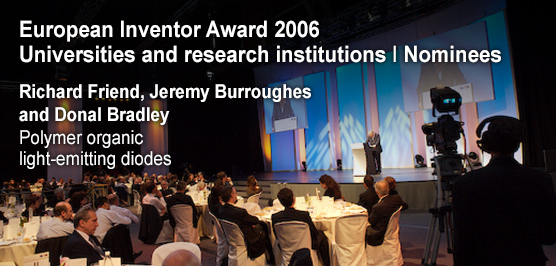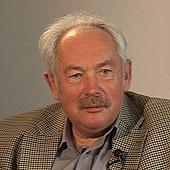Richard Friend, Jeremy Burroughes, Donal Bradley
P-OLEDs (Polymer Organic Light Emitting Diodes)
Thinner is Better
P-OLEDs (Polymer Organic Light Emitting Diodes) may one day pose a serious challenge to the established flat screen display technologies such as LCD or Plasma. Discovered at Cambridge University in 1989 (EP0423283 patent published on January 25, 1995), the inventors – Richard Friend, Jeremy Burroughes and Donal Bradley – formed Cambridge Display Technology (CDT) to exploit the discovery’s commercial potential.
Dr Graham Cross, an independent expert and senior lecturer at the University of Durham, said the discovery was almost a by-product of other polymer research the group were doing at the time, and therefore was “a discovery in the real sense of the word.”
Dr Cross noted that, whether Friend – who in 2003 was knighted for services to physics – was aware of it or not, researchers at the NPL had observed blue light being emitted from a polymer structure a couple of years earlier but this didn’t seem to trigger the response that Friend’s discovery did.
P-OLEDs, unlike traditional LCDs, are an emissive technology and do not require a backlight. CDT claimed, therefore, P-OLEDs could be used to create flat screen displays (and lighting) with superior viewing properties and wider viewing angles while being more power efficient. The lack of backlight also meant the displays could be thinner than existing technology, hence CDT’s “Screen on a T-shirt” catchphrase.
“We are actually three to five years away from a T-shirt with a screen,” said Terry Nicklin, head of marketing at CDT, where of the three inventors only Burroughes, who is in charge of P-OLED strategy and development, still remains. Bradley is now a professor at Imperial College London, while Friend is a professor at Cambridge University But Nicklin added that several P-OLED products are already on the market, including displays used in televisions (produced by both Philips and Dupont in 2005), mobile phones, medical technology in hospitals and in various military applications.
Professor Ian Underwood, who was named Scotland’s top innovator of 2004 by the Royal Society of Edinburgh, co-founded MicroEmissive Displays in 1999, licensed CDT's technology in 2002/3 and announced in 2005 the first shipment of product.
“We looked at the potential of CDT’s P-OLED material and took it in a completely different direction,” said Underwood. “The rest of the world used it to make big screens, we made small screens.” So small, in fact, that his company has held the Guinness World Record for the world’s smallest colour TV screen since 2004.
Underwood explained that the real advantage of P-OLED screens is that they can be used both to improve existing products – such as creating viewfinders in cameras which would give the user the feeling of watching a display the size of a television screen – as well as in brand new inventions. He suggested soon a pair of eyeglasses could be made using a P-OLED display which could receive a digital television signal onto its super-thin surface, giving the viewer a far more cinema-like experience than staring at a traditional three-inch screen.
“The fact that P-OLEDs are so thin and require little power means this could become a reality,” he said.
But many of these ideas are still several years away. Durham’s Dr Cross notes that CDT has made much of their discovery since 1991 and “some commercial success has been achieved.” At the same time, he warned that “it is not yet clear that this discovery will be revolutionary in the manufacture of display devices since there are still many ways to crack the nut.”
The potential is certainly there. Market analysts DisplaySearch state that in the third quarter of 2005 total OLED shipments grew to $16.7 million and revenues reached $130.9 million. OLED shipments increased 144 percent year-on-year due to a 35 percent growth in the MP3 player market.
Osram, a German company using CDT’s P-OLED technology, claims its screens are now used in 45 percent of Flash MP3 players. “And there are still many application areas for P-OLEDs to be explored,” said Nicklin.
Contact
European Inventor Award and Young Inventors Prize queries:
european-inventor@epo.org Subscribe to the European Inventor Award newsletterMedia-related queries:
Contact our Press team#InventorAward #YoungInventors



